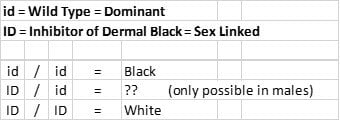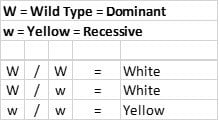I must've misread it. It happens.? In the post you quoted I was talking about auto sexing, not about the sex linked stuff
Navigation
Install the app
How to install the app on iOS
Follow along with the video below to see how to install our site as a web app on your home screen.
Note: This feature may not be available in some browsers.
More options
You are using an out of date browser. It may not display this or other websites correctly.
You should upgrade or use an alternative browser.
You should upgrade or use an alternative browser.
Genetics Help - D^V, Id, Sex link, etc
- Thread starter Demonwolf37
- Start date
SpotTheCat
Herding cats
Thats what I thought happens, I tend to do that frequently. I do appreciate people catching my mistakesI must've misread it. It happens.

- Thread starter
- #13
Okay that's really interesting. Since the roos have two copies instead of just the one, it should be easier to pick them out from the hens.I think there are a few different auto-sexing colours I don’t know too much about them. They can be sexed at hatch be down colour like sex-linked chicks. Barred chickens can be auto-sexing if both parents are barred, the barred gene is incomplete dominant which means if a chicken has two BB they have wider barring then if the had one B. This causes the head spots on the chicks to be bigger if they are BB. But if they are not bred to be auto-sexing then it might not be a reliable way to sex them
I wonder if there are other auto-sexing genes like that, because that's really cool
Happens more when I'm tired.Thats what I thought happens, I tend to do that frequently. I do appreciate people catching my mistakes
The ID/ID gene dilutes leg color. You can use this gene to turn green legs into pure yellow legs, or Slate legs into Pink/White legs.
- Thread starter
- #16
And ID is sex linked as well, right?The ID/ID gene dilutes leg color. You can use this gene to turn green legs into pure yellow legs, or Slate legs into Pink/White legs.
So hens only have one copy?
Yes, it is. To take advantage of this is to breed a black skinned male to a white Skinned Females. You'll get female offspring with black skin, & males with white skin.And ID is sex linked as well, right?
So hens only have one copy?
The Kooky Kiwi
Crowing
My understanding of the terms Auto-Sexing and Sex-Linked are as follows:
Auto-Sexing = When the sex of a day old chick (or 2-3 days old) can be determined by looking at the down color and patterns. For some traits - Male chicks and Female chicks have different down colors and patterns. I think the term is Sexually Dimorphic?
Sex-Linked = Refers to a particular genetic inheritance rule. A male bird has a chromosome pair X / X and a female bird has chromosome pair X / Y. A sex-linked trait will only be present on the X chromosome.
Some people use Sex-Linked traits as a tool for reliable sexing. If they breed a combination of hen and rooster which is known (using the sex-link rule above) to result in different colored hens and cockerels - this can also be reliably used to determine sex at a young age.
Auto-Sexing = When the sex of a day old chick (or 2-3 days old) can be determined by looking at the down color and patterns. For some traits - Male chicks and Female chicks have different down colors and patterns. I think the term is Sexually Dimorphic?
Sex-Linked = Refers to a particular genetic inheritance rule. A male bird has a chromosome pair X / X and a female bird has chromosome pair X / Y. A sex-linked trait will only be present on the X chromosome.
Some people use Sex-Linked traits as a tool for reliable sexing. If they breed a combination of hen and rooster which is known (using the sex-link rule above) to result in different colored hens and cockerels - this can also be reliably used to determine sex at a young age.
The Kooky Kiwi
Crowing
Here's a copy of a post I put on another thread - which talks about shank colour. It may help to answer your question about the leg colours 
I'm working with Black/Blue/Splash NZ Araucana and am taking my time to compile real life examples to match the theoretical info. Information I've gathered includes the following: (Please let me know if there are any errors in these! It's possible!)
*Edited 19.05.21 to provide updates & corrections from other members*
There are two "layers" that influence shank colour
Dermis is the underlying skin structure & tissue
Epidermis is the skin that covers over the Dermis
The Dermis Layer has the following colour options

The EpiDermis Layer has the following colour options

The combined Dermis and EpiDermis colour options

Factors That Enhance Black Dermis Colour
E/E (Extended Black)
ER/ER (Birchen) (Enhances to a lesser degree than E/E)
Factors That Dilute Black Dermis Colour
Bl/bl (Blue)
Bl/Bl (Splash)
c/c (Recessive White)
mo/mo (Mottling)
I/I (Dominant White)
Di/Di (Gold Dilute)
B/B (Barring)
Examples of Enhanced & Diluted - "Borrowed" from https://fionnaschooks.webs.com/araucanagenetics.htm


I'm working with Black/Blue/Splash NZ Araucana and am taking my time to compile real life examples to match the theoretical info. Information I've gathered includes the following: (Please let me know if there are any errors in these! It's possible!)
*Edited 19.05.21 to provide updates & corrections from other members*
There are two "layers" that influence shank colour
Dermis is the underlying skin structure & tissue
Epidermis is the skin that covers over the Dermis
The Dermis Layer has the following colour options

The EpiDermis Layer has the following colour options

The combined Dermis and EpiDermis colour options

Factors That Enhance Black Dermis Colour
E/E (Extended Black)
ER/ER (Birchen) (Enhances to a lesser degree than E/E)
Factors That Dilute Black Dermis Colour
Bl/bl (Blue)
Bl/Bl (Splash)
c/c (Recessive White)
mo/mo (Mottling)
I/I (Dominant White)
Di/Di (Gold Dilute)
B/B (Barring)
Examples of Enhanced & Diluted - "Borrowed" from https://fionnaschooks.webs.com/araucanagenetics.htm

Last edited:
It's Z, & W for birds.My understanding of the terms Auto-Sexing and Sex-Linked are as follows:
Auto-Sexing = When the sex of a day old chick (or 2-3 days old) can be determined by looking at the down color and patterns. For some traits - Male chicks and Female chicks have different down colors and patterns. I think the term is Sexually Dimorphic?
Sex-Linked = Refers to a particular genetic inheritance rule. A male bird has a chromosome pair X / X and a female bird has chromosome pair X / Y. A sex-linked trait will only be present on the X chromosome.
Some people use Sex-Linked traits as a tool for reliable sexing. If they breed a combination of hen and rooster which is known (using the sex-link rule above) to result in different colored hens and cockerels - this can also be reliably used to determine sex at a young age.,
New posts New threads Active threads
-
Latest threads
-
Dropped Egg/Umbilical Hernia?
- Started by Krosfyre9838
- Replies: 0
-
-
-
-
-
-
Threads with more replies in the last 15 days
-
There is a time and place for shenanigans. (edit: THIS is that time and place)
- Started by azurbanclucker
- Replies: 319
-
Caged Bird and Parrot Thread!!!!
- Started by ShrekDawg
- Replies: 241
-
-
-
Open Contest BYC's 4th of July Star Spangled Hatch-Along—Stars, Stripes, & Feathers, a Text-to-Image Contest
- Started by Debbie292d
- Replies: 128
-


